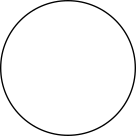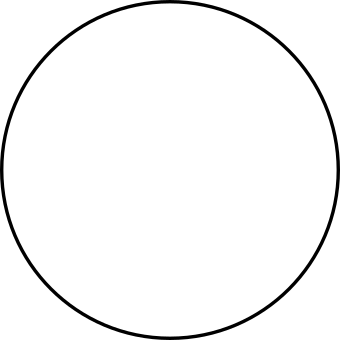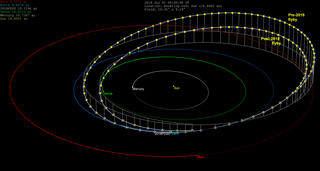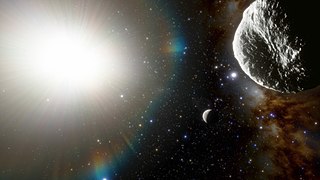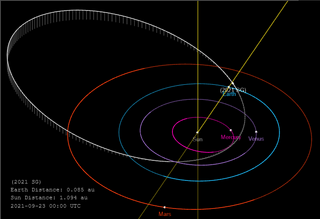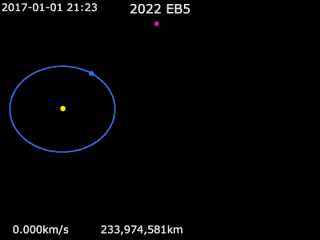Date of
closest
approach | Discovery [note 3] | Object | Nominal geocentric distance [note 4] | Approx.
size (m) | (H)
(abs. mag) | Closer
approach
to Moon
[note 5] |
|---|
| (AU) | (Lunar
distance)
[note 6] |
|---|
| 2021-01-01 [3] | 2021-01-02
G96 Mt. Lemmon Survey [4] | 2021 AA | 0.00159 AU (238,000 km; 148,000 mi) | 0.62 | 11–24 | 27.0 | — |
|
| 2021-01-03 [5] | 2021-01-03
703 Catalina Sky Survey [6] | 2021 AH | 0.00033 AU (49,000 km; 31,000 mi) | 0.13 | 5.3–12 | 28.5 | — |
|
| 2021-01-04 [7] | 2021-01-05
G96 Mt. Lemmon Survey [8] | 2021 AH8 | 0.00035 AU (52,000 km; 33,000 mi) | 0.14 | 3.2–7.2 | 29.6 | — |
|
| 2021-01-09 [9] | 2021-01-08
G96 Mt. Lemmon Survey [10] | 2021 AS2 | 0.00072 AU (108,000 km; 67,000 mi) | 0.28 | 3.2–7.2 | 29.6 | — |
|
| 2021-01-16 [11] | 2021-01-18
G96 Mt. Lemmon Survey [12] | 2021 BR2 | 0.00049 AU (73,000 km; 46,000 mi) | 0.19 | 1.8–4.1 | 30.8 | — |
|
| 2021-01-18 [13] | 2021-01-17
G96 Mt. Lemmon Survey [14] | 2021 BK | 0.00075 AU (112,000 km; 70,000 mi) | 0.29 | 2.3–5.2 | 30.3 | — |
|
| 2021-01-18 [15] | 2021-01-17
703 Catalina Sky Survey [16] | 2021 BV1 | 0.00161 AU (241,000 km; 150,000 mi) | 0.62 | 6.6–15 | 28.0 | — |
|
| 2021-01-18 [17] | 2021-01-17
G96 Mt. Lemmon Survey [18] | 2021 BO | 0.00016 AU (24,000 km; 15,000 mi) | 0.06 | 0.68–1.5 | 33.0 | — |
|
| 2021-01-20 [19] | 2021-01-18
G96 Mt. Lemmon Survey [20] | 2021 BO1 | 0.00168 AU (251,000 km; 156,000 mi) | 0.65 | 3.8–8.6 | 29.2 | — |
|
| 2021-01-26 [21] | 2018-01-18 [22] | 2018 BA3 | 0.00250 AU (374,000 km; 232,000 mi) | 0.97 | 14–31 | 26.4 | — |
|
| 2021-02-04 [23] | 2021-02-05
703 Catalina Sky Survey [24] | 2021 CV | 0.00135 AU (202,000 km; 125,000 mi) | 0.52 | 4.4–9.9 | 28.9 | — |
|
| 2021-02-09 [25] | 2021-02-09
I41 Palomar Mountain—ZTF [26] | 2021 CZ3 | 0.00015 AU (22,000 km; 14,000 mi) | 0.06 | 1.7–3.8 | 31.0 | — |
|
| 2021-02-11 [27] | 2021-02-05
703 Catalina Sky Survey [28] | 2021 CO | 0.00242 AU (362,000 km; 225,000 mi) | 0.94 | 23–52 | 25.3 | — |
|
| 2021-02-11 [29] | 2021-02-11
703 Catalina Sky Survey [30] | 2021 CQ5 | 0.00119 AU (178,000 km; 111,000 mi) | 0.46 | 5.1–11 | 28.6 | — |
|
| 2021-02-12 [31] | 2021-02-11
V00 Kitt Peak-Bok [32] | 2021 CC6 | 0.00113 AU (169,000 km; 105,000 mi) | 0.44 | 2.5–5.5 | 30.1 | — |
|
| 2021-02-12 [33] | 2021-02-12
381 Tokyo-Kiso [34] | 2021 CC7 | 0.00217 AU (325,000 km; 202,000 mi) | 0.84 | 3.0–6.7 | 29.7 | — |
|
| 2021-02-13 [35] | 2021-02-10
F51 Pan-STARRS 1, Haleakala [36] | 2021 CA6 | 0.00111 AU (166,000 km; 103,000 mi) | 0.43 | 5.2–12 | 28.6 | — |
|
| 2021-02-14 [37] | 2021-02-12
T08 ATLAS-MLO, Mauna Loa [38] | 2021 CS6 | 0.00100 AU (150,000 km; 93,000 mi) | 0.39 | 7.3–16 | 27.8 | — |
|
| 2021-02-14 [39] | 2021-02-13
K88 GINOP-KHK, Piszkesteto [40] | 2021 CW7 | 0.00019 AU (28,000 km; 18,000 mi) | 0.07 | 1.5–3.4 | 31.2 | — |
|
| 2021-02-18 [41] | 2021-02-18
I41 Palomar Mountain—ZTF [42] | 2021 DN1 | 0.00226 AU (338,000 km; 210,000 mi) | 0.88 | 6.3–14 | 28.1 | — |
|
| 2021-02-18 [43] | 2021-02-17
G96 Mt. Lemmon Survey [44] | 2021 DG | 0.00111 AU (166,000 km; 103,000 mi) | 0.43 | 2.2–4.9 | 30.4 | — |
|
| 2021-02-21 [45] | 2021-02-22
K88 GINOP-KHK, Piszkesteto [46] | 2021 DA2 | 0.00132 AU (197,000 km; 123,000 mi) | 0.51 | 3.9–8.7 | 29.2 | — |
|
| 2021-03-01 | 2021-03-02 | ZTF0KfF | 0.00187 AU (280,000 km; 174,000 mi) | 0.73 [note 7] | 0.96–5.9 | 31.0 | ? [47] |
|
| 2021-03-02 [48] | 2021-03-01
K88 GINOP-KHK, Piszkesteto [49] | 2021 EA | 0.00063 AU (94,000 km; 59,000 mi) | 0.24 | 6.3–14 | 28.1 | — |
|
| 2021-03-07 | 2021-03-06 | C4YK182 | 0.000632 AU (94,500 km; 58,700 mi) | 0.25 [note 8] | 1.8–5.9 | 30.3 | — [50] |
|
| 2021-03-08 [51] | 2021-03-06
G96 Mt. Lemmon Survey [52] | 2021 EF1 | 0.00187 AU (280,000 km; 174,000 mi) | 0.73 | 3.1–6.8 | 29.7 | ✓ |
|
| 2021-03-09 [53] | 2021-03-10
G96 Mt. Lemmon Survey [54] | 2021 EG3 | 0.00098 AU (147,000 km; 91,000 mi) | 0.38 | 3.8–8.6 | 29.2 | — |
|
| 2021-03-10 | 2021-03-11 | ScKo07a | 0.0013 AU (190,000 km; 120,000 mi) | 0.51 [note 9] | 0.97–5.9 | 31.0 | — [55] |
|
| 2021-03-15 [56] | 2021-03-15
T08 ATLAS-MLO, Mauna Loa [57] | 2021 EN4 | 0.00047 AU (70,000 km; 44,000 mi) | 0.18 | 3.1–6.9 | 29.7 | — |
|
| 2021-03-15 [58] | 2021-03-15
381 Tokyo-Kiso [59] | 2021 EP4 | 0.00248 AU (371,000 km; 231,000 mi) | 0.97 | 3.7–8.4 | 29.3 | — |
|
| 2021-03-16 [60] | 2021-03-11
G96 Mt. Lemmon Survey [61] | 2021 EQ3 | 0.00186 AU (278,000 km; 173,000 mi) | 0.72 | 16–36 | 26.1 | ✓ |
|
| 2021-03-20 [62] | 2021-03-22
G96 Mt. Lemmon Survey [63] | 2021 FM2 | 0.00056 AU (84,000 km; 52,000 mi) | 0.22 | 2.5–5.7 | 30.1 | — |
|
| 2021-03-21 [64] | 2021-03-22
G96 Mt. Lemmon Survey [65] | 2021 FF2 | 0.00213 AU (319,000 km; 198,000 mi) | 0.83 | 6.3–14 | 28.1 | — |
|
| 2021-03-23 | 2021-03-23 | B03SK22 | 0.00019 AU (28,000 km; 18,000 mi) | 0.074 [note 10] | 0.38–2.4 | 33.0 | — [66] |
|
| 2021-03-23 [67] | 2021-03-20
G96 Mt. Lemmon Survey [68] | 2021 FO1 | 0.00215 AU (322,000 km; 200,000 mi) | 0.84 | 3.4–7.6 | 29.5 | — |
|
| 2021-03-23 [69] | 2021-03-18
G96 Mt. Lemmon Survey [70] | 2021 FH | 0.00157 AU (235,000 km; 146,000 mi) | 0.61 | 12–27 | 26.7 | — |
|
| 2021-03-23 [71] | 2021-03-22
G96 Mt. Lemmon Survey [72] | 2021 FP2 | 0.00216 AU (323,000 km; 201,000 mi) | 0.84 | 2.5–5.6 | 30.1 | — |
|
| 2021-04-01 | 2021-04-01 | A10w8qG | 0.00149 AU (223,000 km; 139,000 mi) | 0.58 [note 11] | 3.2–12 | 28.9 | ✓ [73] |
|
| 2021-04-03 [74] | 2021-04-04
G96 Mt. Lemmon Survey [75] | 2021 GE2 | 0.00161 AU (241,000 km; 150,000 mi) | 0.62 | 3.9–8.8 | 29.1 | — |
|
| 2021-04-03 | 2021-04-06 | P11ekJ0 | 0.00188 AU (281,000 km; 175,000 mi) | 0.73 [note 12] | 2.9–18 | 28.6 | — [76] |
|
| 2021-04-04 [77] | 2021-04-03
G96 Mt. Lemmon Survey [78] | 2021 GV | 0.00224 AU (335,000 km; 208,000 mi) | 0.87 | 3.8–8.6 | 29.2 | — |
|
| 2021-04-05 [79] | 2021-04-03
G96 Mt. Lemmon Survey [80] | 2021 GS | 0.00167 AU (250,000 km; 155,000 mi) | 0.65 | 4.8–11 | 28.7 | — |
|
| 2021-04-05 [81] | 2021-04-05
I41 Palomar Mountain—ZTF [82] | 2021 GZ7 | 0.00126 AU (188,000 km; 117,000 mi) | 0.49 | 4.3–9.6 | 28.9 | ✓ |
|
| 2021-04-06 | 2021-04-07 | P11eyxx | 0.00024 AU (36,000 km; 22,000 mi) | 0.093 [note 13] | 1.4–5.4 | 30.7 | — [83] |
|
| 2021-04-08 | 2021-04-07 | A10wiOp | 0.00224 AU (335,000 km; 208,000 mi) | 0.87 [note 14] | 2.8–17 | 28.7 | — [84] |
|
| 2021-04-08 [85] | 2021-04-08
381 Tokyo-Kiso [86] | 2021 GV4 | 0.00212 AU (317,000 km; 197,000 mi) | 0.82 | 4.3–9.6 | 29.0 | — |
|
| 2021-04-09 [87] | 2021-04-11
T08 ATLAS-MLO, Mauna Loa [88] | 2021 GL16 | 0.00247 AU (370,000 km; 230,000 mi) | 0.96 | 15–33 | 26.3 | ✓ |
|
| 2021-04-10 [89] | 2021-04-06
F51 Pan-STARRS 1, Haleakala [90] | 2021 GT3 | 0.00171 AU (256,000 km; 159,000 mi) | 0.67 | 14–32 | 26.4 | — |
|
| 2021-04-10 | 2021-04-10 | TMG0042 | 0.00220 AU (329,000 km; 205,000 mi) | 0.85 [note 15] | 4.4–14.3 | 28.4 | — [91] |
|
| 2021-04-11 [92] | 2021-04-10
703 Catalina Sky Survey [93] | 2021 GQ5 | 0.00248 AU (371,000 km; 231,000 mi) | 0.97 | 5.3–12 | 28.5 | — |
|
| 2021-04-11 | 2021-04-11 | TMG0044 | 0.00126 AU (188,000 km; 117,000 mi) | 0.49 [note 16] | 2.5–9.9 | 29.4 | — [94] |
|
| 2021-04-11 | 2021-04-07 | P11exfR | 0.00244 AU (365,000 km; 227,000 mi) | 0.95 [note 17] | 3.1–19 | 28.5 | — [95] |
|
| 2021-04-11 | 2021-04-11 | TMG0045 | 0.00156 AU (233,000 km; 145,000 mi) | 0.61 [note 18] | 3.7–12 | 28.8 | — [96] |
|
| 2021-04-11 [97] | 2021-04-11
381 Tokyo-Kiso [98] | 2021 GA168 | 0.00156 AU (233,000 km; 145,000 mi) | 0.61 | 4.6–10 | 28.8 | — |
|
| 2021-04-12 [99] | 2021-04-08
G96 Mt. Lemmon Survey [100] | 2021 GW4 | 0.00018 AU (27,000 km; 17,000 mi) | 0.07 | 3.4–7.6 | 29.5 | — |
|
| 2021-04-13 [101] | 2021-04-13
I41 Palomar Mountain—ZTF [102] | 2021 GC13 | 0.00228 AU (341,000 km; 212,000 mi) | 0.89 | 4.0–8.9 | 29.1 | — |
|
| 2021-04-13 | 2021-04-13 | ZTF0KwS | 0.00105 AU (157,000 km; 98,000 mi) | 0.41 [note 19] | 2.4–15 | 29.0 | ? [103] |
|
| 2021-04-13 [104] | 2021-04-11
V00 Kitt Peak-Bok [105] | 2021 GC8 | 0.00146 AU (218,000 km; 136,000 mi) | 0.57 | 2.0–4.5 | 30.6 | — |
|
| 2021-04-14 [106] | 2021-04-14
381 Tokyo-Kiso [107] | 2021 GQ10 | 0.00116 AU (174,000 km; 108,000 mi) | 0.45 | 12–28 | 26.6 | — |
|
| 2021-04-14 [108] | 2021-04-15
T08 ATLAS-MLO, Mauna Loa [109] | 2021 GW16 | 0.00020 AU (30,000 km; 19,000 mi) | 0.08 | 2.5–5.7 | 30.1 | — |
|
| 2021-04-15 [110] | 2021-04-17
T05 ATLAS-HKO, Haleakala [111] | 2021 HC1 | 0.00155 AU (232,000 km; 144,000 mi) | 0.60 | 6.8–15 | 28.0 | ✓ |
|
| 2021-04-15 [112] | 2021-04-14
W94 MAP, San Pedro de Atacama [113] | 2021 GF10 | 0.00077 AU (115,000 km; 72,000 mi) | 0.30 | 6.2–14 | 28.2 | — |
|
| 2021-04-15 [114] | 2021-04-14
F51 Pan-STARRS 1, Haleakala [115] | 2021 GN10 | 0.00192 AU (287,000 km; 178,000 mi) | 0.75 | 5.6–12 | 28.4 | ✓ |
|
| 2021-04-16 | 2021-04-17 | ZTF0KyD | 0.00213 AU (319,000 km; 198,000 mi) | 0.83 [note 20] | 3.2–20 | 28.4 | ? [116] |
|
| 2021-04-17 [117] | 2021-04-18
703 Catalina Sky Survey [118] | 2021 HE1 | 0.00153 AU (229,000 km; 142,000 mi) | 0.59 | 4.4–9.7 | 28.9 | ✓ |
|
| 2021-04-17 | 2021-04-14 | P11f7ua | 0.00108 AU (162,000 km; 100,000 mi) | 0.42 [note 21] | 2.9–9.4 | 29.3 | — [119] |
|
| 2021-04-17 | 2021-04-17 | B04SK17 | 0.00106 AU (159,000 km; 99,000 mi) | 0.41 [note 22] | 3.1–30 | 28.0 | ? [120] |
|
| 2021-04-19 [121] | 2021-04-17
G96 Mt. Lemmon Survey [122] | 2021 HN | 0.00170 AU (254,000 km; 158,000 mi) | 0.66 | 11–25 | 26.9 | — |
|
| 2021-04-23 | 2021-04-25 | A10wMMp | 0.000735 AU (110,000 km; 68,300 mi) | 0.29 [note 23] | 2.5–16 | 28.9 | ? [123] |
|
| 2021-04-24 | 2021-04-24 | ZTF0Kzz | 0.0016 AU (240,000 km; 150,000 mi) | 0.62 [note 24] | 1.2–7.5 | 30.5 | ? [124] |
|
| 2021-05-02 | 2021-05-02 | S514008 | 0.00079 AU (118,000 km; 73,000 mi) | 0.31 [note 25] | 2.4–15 | 29.0 | ? [125] |
|
| 2021-05-02 [126] | 2021-05-03
T05 ATLAS-HKO, Haleakala [127] | 2021 JW | 0.00173 AU (259,000 km; 161,000 mi) | 0.67 | 8.0–18 | 27.6 | — |
|
| 2021-05-04 [128] | 2021-05-03
T05 ATLAS-HKO, Haleakala [129] | 2021 JV | 0.00094 AU (141,000 km; 87,000 mi) | 0.36 | 8.6–19 | 27.4 | — |
|
| 2021-05-06 [130] | 2021-05-05
G96 Mt. Lemmon Survey [131] | 2021 JS1 | 0.00074 AU (111,000 km; 69,000 mi) | 0.29 | 5.3–12 | 28.5 | — |
|
| 2021-05-07 | 2021-05-09 | P11gae7 | 0.00126 AU (188,000 km; 117,000 mi) | 0.49 [note 26] | 3.1–19 | 28.5 | — [132] |
|
| 2021-05-08 [133] | 2021-05-07
G96 Mt. Lemmon Survey [134] | 2021 JQ2 | 0.00045 AU (67,000 km; 42,000 mi) | 0.17 | 2.6–5.9 | 30.0 | — |
|
| 2021-05-08 | 2021-05-09 | P11gae5 | 0.00057 AU (85,000 km; 53,000 mi) | 0.22 [note 27] | 1.3–8.2 | 30.3 | — [135] |
|
| 2021-05-09 | 2021-05-12 | P11ggM3 | 0.00235 AU (352,000 km; 218,000 mi) | 0.91 [note 28] | 1.2–7.5 | 30.5 | — [136] |
|
| 2021-05-13 [137] | 2021-05-08
F51 Pan-STARRS 1, Haleakala [138] | 2021 JB6 | 0.00071 AU (106,000 km; 66,000 mi) | 0.27 | 4.7–10 | 28.8 | — |
|
| 2021-05-14 [139] | 2021-05-14
I41 Palomar Mountain—ZTF [140] | 2021 JU6 | 0.00044 AU (66,000 km; 41,000 mi) | 0.17 | 10–23 | 27.1 | — |
|
| 2021-05-27 [141] | 2021-06-01
F51 Pan-STARRS 1, Haleakala [142] | 2021 LV | 0.00188 AU (281,000 km; 175,000 mi) | 0.73 | 6.9–15 | 27.9 | ✓ |
|
| 2021-05-30 [143] | 2021-05-30
381 Tokyo-Kiso [144] | 2021 KO2 | 0.00248 AU (371,000 km; 231,000 mi) | 0.96 | 6.6–15 | 28.0 | — |
|
| 2021-05-30 | 2021-05-30 | TMG0049 | 0.000726 AU (108,600 km; 67,500 mi) | 0.28 [note 29] | 2.2–7.1 | 29.9 | — [145] |
|
| 2021-05-31 [146] | 2021-05-30
381 Tokyo-Kiso [147] | 2021 KN2 | 0.00097 AU (145,000 km; 90,000 mi) | 0.38 | 5.0–11 | 28.6 | — |
|
| 2021-05-31 [148] | 2021-05-31
381 Tokyo-Kiso [149] | 2021 KQ2 | 0.00119 AU (178,000 km; 111,000 mi) | 0.46 | 2.7–6.1 | 30.0 | — |
|
| 2021-05-31 | 2021-05-31 | C5Q2Z32 | 0.0000774 AU (11,580 km; 7,190 mi) | 0.030 [note 30] | 0.67–4.1 | 31.8 | — [150] |
|
| 2021-06-01 [151] | 2021-05-31
G96 Mt. Lemmon Survey [152] | 2021 KT2 | 0.00195 AU (292,000 km; 181,000 mi) | 0.76 | 5.6–12 | 28.4 | — |
|
| 2021-06-04 [153] | 2021-06-05
T05 ATLAS-HKO, Haleakala [154] | 2021 LX1 | 0.00107 AU (160,000 km; 99,000 mi) | 0.42 | 10–23 | 27.1 | — |
|
| 2021-06-12 [155] | 2021-06-11
F51 Pan-STARRS 1, Haleakala [156] | 2021 LG5 | 0.00106 AU (159,000 km; 99,000 mi) | 0.41 | 4.8–11 | 28.7 | — |
|
| 2021-06-13 [157] | 2021-06-08
G96 Mt. Lemmon Survey [158] | 2021 LO2 | 0.00148 AU (221,000 km; 138,000 mi) | 0.58 | 6.6–15 | 28.0 | — |
|
| 2021-06-15 [159] | 2021-06-18
W94 MAP, San Pedro de Atacama [160] | 2021 MU | 0.00111 AU (166,000 km; 103,000 mi) | 0.43 | 8.8–20 | 27.4 | — |
|
| 2021-06-17 [161] | 2021-06-17
T05 ATLAS-HKO, Haleakala [162] | 2021 ME | 0.00212 AU (317,000 km; 197,000 mi) | 0.82 | 4.3–9.6 | 29.0 | — |
|
| 2021-07-03 [163] | 2021-07-01
F51 Pan-STARRS 1, Haleakala [164] | 2021 NA | 0.00044 AU (66,000 km; 41,000 mi) | 0.17 | 5.2–12 | 28.6 | — |
|
| 2021-07-08 [165] | 2021-07-09
F51 Pan-STARRS 1, Haleakala [166] | 2021 NU3 | 0.00120 AU (180,000 km; 112,000 mi) | 0.47 | 5.0–11 | 28.6 | — |
|
| 2021-07-20 [167] | 2021-07-19
W94 MAP, San Pedro de Atacama [168] | 2021 OV | 0.00131 AU (196,000 km; 122,000 mi) | 0.51 | 7.5–17 | 27.8 | ✓ |
|
| 2021-07-31 [169] | 2021-07-30
T08 ATLAS-MLO, Mauna Loa [170] | 2021 OD1 | 0.00170 AU (254,000 km; 158,000 mi) | 0.66 | 5.9–13 | 28.3 | — |
|
| 2021-08-02 [171] | 2021-08-02
I41 Palomar Mountain—ZTF [172] | 2021 PC | 0.00110 AU (165,000 km; 102,000 mi) | 0.43 | 12–27 | 26.7 | — |
|
| 2021-08-02 [173] | 2021-08-02
T08 ATLAS-MLO [174] | 2021 PL132 | 0.00233 AU (349,000 km; 217,000 mi) | 0.91 | 5.2–12 | 28.5 | — |
|
| 2021-08-05 [175] | 2021-08-07
F51 Pan-STARRS 1, Haleakala [176] | 2021 PY4 | 0.00188 AU (281,000 km; 175,000 mi) | 0.73 | 13–29 | 26.5 | — |
|
| 2021-08-06 [177] | 2021-08-08
W94 MAP, San Pedro de Atacama [178] | 2021 PK4 | 0.00160 AU (239,000 km; 149,000 mi) | 0.62 | 6.1–14 | 28.2 | — |
|
| 2021-08-14 [179] | 2021-08-15
T05 ATLAS-HKO, Haleakala [180] | 2021 PA17 | 0.00045 AU (67,000 km; 42,000 mi) | 0.17 | 7.3–16 | 27.8 | — |
|
| 2021-08-27 [181] | 2021-08-27
T05 ATLAS-HKO, Haleakala [182] | 2021 QD1 | 0.00204 AU (305,000 km; 190,000 mi) | 0.80 | 4.8–11 | 28.7 | — |
|
| 2021-08-28 [183] | 2021-08-30
F51 Pan-STARRS 1, Haleakala [184] | 2021 QV3 | 0.00085 AU (127,000 km; 79,000 mi) | 0.33 | 2.4–5.3 | 30.2 | — |
|
| 2021-09-02 [185] | 2021-09-03
I41 Palomar Mountain—ZTF [186] | 2021 RN5 | 0.00253 AU (378,000 km; 235,000 mi) | 0.98 | 8.1–18 | 27.6 | ✓ |
|
| 2021-09-06 [187] | 2021-09-08
F51 Pan-STARRS 1, Haleakala [188] | 2021 RT4 | 0.00177 AU (265,000 km; 165,000 mi) | 0.69 | 6.2–14 | 28.2 | — |
|
| 2021-09-07 [189] | 2021-09-08
F51 Pan-STARRS 1, Haleakala [190] | 2021 RS100 | 0.00128 AU (191,000 km; 119,000 mi) | 0.50 | 4.7–11 | 28.8 | ✓ |
|
| 2021-09-08 [191] | 2021-09-07
G96 Mt. Lemmon Survey [192] | 2021 RS2 | 0.00015 AU (22,000 km; 14,000 mi) | 0.06 | 2.3–5.1 | 30.4 | — |
|
| 2021-09-08 [193] | 2021-09-07
703 Catalina Sky Survey [194] | 2021 RP2 | 0.00080 AU (120,000 km; 74,000 mi) | 0.31 | 2.3–5.2 | 30.3 | ✓ |
|
| 2021-09-08 [195] | 2021-09-09
K88 GINOP-KHK, Piszkesteto [196] | 2021 RS5 | 0.00092 AU (138,000 km; 86,000 mi) | 0.36 | 5.7–13 | 28.3 | — |
|
| 2021-09-09 [197] | 2021-09-05
T05 ATLAS-HKO, Haleakala [198] | 2021 RQ2 | 0.00126 AU (188,000 km; 117,000 mi) | 0.49 | 3.3–7.3 | 29.5 | — |
|
| 2021-09-09 [199] | 2021-09-10
703 Catalina Sky Survey [200] | 2021 RB6 | 0.00172 AU (257,000 km; 160,000 mi) | 0.67 | 6.6–15 | 28.0 | — |
|
| 2021-09-11 [201] | 2021-09-10
T05 ATLAS-HKO, Haleakala [202] | 2021 RG6 | 0.00057 AU (85,000 km; 53,000 mi) | 0.22 | 4.4–9.8 | 28.9 | — |
|
| 2021-09-11 [203] | 2021-09-12
T08 ATLAS-MLO, Mauna Loa [204] | 2021 RG12 | 0.00217 AU (325,000 km; 202,000 mi) | 0.84 | 3.9–8.7 | 29.2 | — |
|
| 2021-09-12 [205] | 2021-09-08
G96 Mt. Lemmon Survey [206] | 2021 RR5 | 0.00053 AU (79,000 km; 49,000 mi) | 0.20 | 5.6–12 | 28.4 | — |
|
| 2021-09-16 [207] | 2021-09-13
F51 Pan-STARRS 1, Haleakala [208] | 2021 RF16 | 0.00213 AU (319,000 km; 198,000 mi) | 0.83 | 4.3–9.6 | 29.0 | — |
|
| 2021-09-16 [209] | 2021-09-17
I41 Palomar Mountain—ZTF [210] | 2021 SG | 0.00164 AU (245,000 km; 152,000 mi) | 0.64 | 42–94 | 24.0 | — |
|
| 2021-09-17 [211] | 2021-09-17
I41 Palomar Mountain—ZTF [212] | 2021 SP | 9.43×10−5 AU (1.411×104 km; 8.77×103 mi) | 0.04 | 3.7–8.3 | 29.3 | — |
|
| 2021-09-20 [213] | 2021-09-23
F51 Pan-STARRS 1, Haleakala [214] | 2021 SQ | 0.00184 AU (275,000 km; 171,000 mi) | 0.72 | 5.5–12 | 28.4 | ✓ |
|
| 2021-09-26 [215] | 2021-09-28
F52 Pan-STARRS 2, Haleakala [216] | 2021 SW1 | 0.00182 AU (272,000 km; 169,000 mi) | 0.71 | 2.9–6.5 | 29.8 | — |
|
| 2021-09-27 [217] | 2021-09-28
T05 ATLAS-HKO, Haleakala [218] | 2021 SQ1 | 0.00111 AU (166,000 km; 103,000 mi) | 0.43 | 4.6–10 | 28.8 | — |
|
| 2021-09-30 [219] | 2021-10-02
G96 Mt. Lemmon Survey [220] | 2021 TT | 0.00089 AU (133,000 km; 83,000 mi) | 0.34 | 7.2–16 | 27.8 | — |
|
| 2021-10-01 [221] | 2021-10-02
F52 Pan-STARRS 2, Haleakala [222] | 2021 TX | 0.00028 AU (42,000 km; 26,000 mi) | 0.11 | 1.5–3.5 | 31.2 | — |
|
| 2021-10-03 [223] | 2021-10-03
T08 ATLAS-MLO, Mauna Loa [224] | 2021 TV1 | 0.00108 AU (162,000 km; 100,000 mi) | 0.42 | 6.5–14 | 28.1 | — |
|
| 2021-10-03 [225] | 2021-10-03
G96 Mt. Lemmon Survey [226] | 2021 TG1 | 0.00196 AU (293,000 km; 182,000 mi) | 0.76 | 6.1–14 | 28.2 | — |
|
| 2021-10-06 [227] | 2021-10-06
381 Tokyo-Kiso [228] | 2021 TQ4 | 0.00255 AU (381,000 km; 237,000 mi) | 0.99 | 2.8–6.2 | 29.9 | — |
|
| 2021-10-10 [229] | 2021-10-03
F52 Pan-STARRS 2, Haleakala [230] | 2021 TT1 | 0.00251 AU (375,000 km; 233,000 mi) | 0.97 | 15–34 | 26.2 | ✓ |
|
| 2021-10-11 [231] | 2021-10-11
T05 ATLAS-HKO, Haleakala [232] | 2021 TK11 | 0.00091 AU (136,000 km; 85,000 mi) | 0.35 | 4.9–11 | 28.7 | — |
|
| 2021-10-11 [233] | 2021-10-11
T05 ATLAS-HKO, Haleakala [234] | 2021 TT13 | 0.00036 AU (54,000 km; 33,000 mi) | 0.14 | 2.9–6.5 | 29.8 | — |
|
| 2021-10-11 [235] | 2021-10-13
F51 Pan-STARRS 1, Haleakala [236] | 2021 TH15 | 0.00211 AU (316,000 km; 196,000 mi) | 0.82 | 4.5–10 | 28.8 | ✓ |
|
| 2021-10-12 [237] | 2021-10-13
G96 Mt. Lemmon Survey [238] | 2021 TE13 | 0.00018 AU (27,000 km; 17,000 mi) | 0.07 | 3.7–8.2 | 29.3 | — |
|
| 2021-10-14 [239] | 2021-10-14
T05 ATLAS-HKO, Haleakala [240] | 2021 TM14 | 0.00098 AU (147,000 km; 91,000 mi) | 0.38 | 6.7–15 | 28.0 | — |
|
| 2021-10-16 [241] | 2021-10-16
703 Catalina Sky Survey [242] | 2021 UL | 0.00024 AU (36,000 km; 22,000 mi) | 0.09 | 2.3–5.2 | 30.3 | ✓ |
|
| 2021-10-16 [243] | 2021-10-14
G96 Mt. Lemmon Survey [244] | 2021 TJ15 | 0.00257 AU (384,000 km; 239,000 mi) | 1.00 | 5.6–13 | 28.4 | — |
|
| 2021-10-18 [245] | 2021-10-11
F51 Pan-STARRS 1, Haleakala [246] | 2021 TG14 | 0.00167 AU (250,000 km; 155,000 mi) | 0.65 | 6.0–14 | 28.2 | — |
|
| 2021-10-24 [247] | 2021-10-24
K88 GINOP-KHK, Piszkesteto [248] | 2021 UT | 0.00100 AU (150,000 km; 93,000 mi) | 0.39 | 3.6–8.1 | 29.3 | — |
|
| 2021-10-25 [249] | 2021-10-26
G96 Mt. Lemmon Survey [250] | 2021 UO1 | 0.00102 AU (153,000 km; 95,000 mi) | 0.40 | 6.7–15 | 28.0 | — |
|
| 2021-10-25 [251] | 2021-10-25
703 Catalina Sky Survey [252] | 2021 UA1 | 6.30×10−5 AU (9.42×103 km; 5.86×103 mi) | 0.02 | 1.2–2.6 | 31.8 | — |
|
| 2021-10-27 [2] | 2021-10-28
G96 Mt. Lemmon Survey [253] | 2021 UA7 | 0.00086 AU (129,000 km; 80,000 mi) | 0.33 | 4.7–11 | 28.8 | — |
|
| 2021-10-27 [254] | 2021-10-26
G96 Mt. Lemmon Survey [255] | 2021 UH1 | 0.00048 AU (72,000 km; 45,000 mi) | 0.19 | 1.3–2.8 | 31.6 | — |
|
| 2021-10-29 [256] | 2021-10-30
W94 MAP, San Pedro de Atacama [257] | 2021 UV5 | 0.00077 AU (115,000 km; 72,000 mi) | 0.30 | 4.6–10 | 28.8 | — |
|
| 2021-10-29 [258] | 2021-10-31
K88 GINOP-KHK, Piszkesteto [259] | 2021 UT5 | 0.00205 AU (307,000 km; 191,000 mi) | 0.80 | 5.8–13 | 28.3 | — |
|
| 2021-10-29 [260] | 2021-10-29
381 Tokyo-Kiso [261] | 2021 UF12 | 0.00161 AU (241,000 km; 150,000 mi) | 0.63 | 3.7–8.2 | 29.3 | — |
|
| 2021-10-30 [262] | 2021-10-27
G96 Mt. Lemmon Survey [263] | 2021 UW1 | 0.00256 AU (383,000 km; 238,000 mi) | 0.99 | 16–35 | 26.1 | — |
|
| 2021-10-30 [264] | 2021-10-31
T08 ATLAS-MLO, Mauna Loa [265] | 2021 UJ6 | 0.00232 AU (347,000 km; 216,000 mi) | 0.90 | 6.0–13 | 28.3 | — |
|
| 2021-11-01 [266] | 2021-11-02
T08 ATLAS-MLO, Mauna Loa [267] | 2021 VH | 0.00020 AU (30,000 km; 19,000 mi) | 0.08 | 3.2–7.1 | 29.6 | — |
|
| 2021-11-04 [268] | 2021-10-31
F51 Pan-STARRS 1, Haleakala [269] | 2021 UO7 | 0.00247 AU (370,000 km; 230,000 mi) | 0.96 | 3.3–7.3 | 29.6 | — |
|
| 2021-11-07 [270] | 2021-11-11
G96 Mt. Lemmon Survey [271] | 2021 VS11 | 0.00204 AU (305,000 km; 190,000 mi) | 0.79 | 2.2–4.8 | 28.7 | — |
|
| 2021-11-07 [272] | 2021-11-06
G96 Mt. Lemmon Survey [273] | 2021 VK3 | 0.00057 AU (85,000 km; 53,000 mi) | 0.22 | 2.2–4.8 | 30.5 | — |
|
| 2021-11-08 [274] | 2021-11-07
T08 ATLAS-MLO, Mauna Loa [275] | 2021 VL3 | 0.00111 AU (166,000 km; 103,000 mi) | 0.43 | 5.5–12 | 28.4 | — |
|
| 2021-11-08 [276] | 2021-11-07
G96 Mt. Lemmon Survey [277] | 2021 VN3 | 0.00092 AU (138,000 km; 86,000 mi) | 0.36 | 2.0–4.6 | 30.6 | — |
|
| 2021-11-08 [278] | 2021-11-07
G96 Mt. Lemmon Survey [279] | 2021 VM3 | 0.00204 AU (305,000 km; 190,000 mi) | 0.79 | 2.9–6.5 | 29.8 | — |
|
| 2021-11-09 [280] | 2021-11-10
G96 Mt. Lemmon Survey [281] | 2021 VD8 | 0.00083 AU (124,000 km; 77,000 mi) | 0.32 | 2.4–5.4 | 30.2 | — |
|
| 2021-11-09 [282] | 2021-11-09
G96 Mt. Lemmon Survey [283] | 2021 VP11 | 0.00039 AU (58,000 km; 36,000 mi) | 0.15 | 1.2–2.6 | 31.8 | — |
|
| 2021-11-10 [284] | 2021-11-08
F52 Pan-STARRS 2, Haleakala [285] | 2021 VU4 | 0.00072 AU (108,000 km; 67,000 mi) | 0.28 | 5.6–13 | 28.4 | — |
|
| 2021-11-11 [286] | 2021-11-10
G96 Mt. Lemmon Survey [287] | 2021 VY7 | 0.00214 AU (320,000 km; 199,000 mi) | 0.83 | 3.7–8.3 | 29.3 | — |
|
| 2021-11-12 [288] | 2021-11-10
G96 Mt. Lemmon Survey [289] | 2021 VC7 | 0.00124 AU (186,000 km; 115,000 mi) | 0.48 | 6.1–14 | 28.2 | — |
|
| 2021-11-21 [290] | 2021-11-24
T08 ATLAS-MLO, Mauna Loa [291] | 2021 WP | 0.00104 AU (156,000 km; 97,000 mi) | 0.41 | 6.7–15 | 28.0 | — |
|
| 2021-11-26 [292] | 2021-11-27
703 Catalina Sky Survey [293] | 2021 WA1 | 0.00206 AU (308,000 km; 191,000 mi) | 0.80 | 8.2–18 | 27.5 | ✓ |
|
| 2021-11-28 [294] | 2021-11-27
G96 Mt. Lemmon Survey [295] | 2021 WC1 | 0.00136 AU (203,000 km; 126,000 mi) | 0.53 | 5.4–12 | 28.5 | — |
|
| 2021-11-30 [296] | 2021-12-02
G96 Mt. Lemmon Survey [297] | 2021 XV | 0.00136 AU (203,000 km; 126,000 mi) | 0.39 | 2.6–5.8 | 30.1 | — |
|
| 2021-12-01 [298] | 2021-11-29
G96 Mt. Lemmon Survey [299] | 2021 WF3 | 0.00096 AU (144,000 km; 89,000 mi) | 0.37 | 3.5–7.9 | 29.4 | — |
|
| 2021-12-01 [300] | 2021-12-02
I41 Palomar Mountain—ZTF [301] | 2021 XL | 0.00135 AU (202,000 km; 125,000 mi) | 0.53 | 4.5–10 | 28.9 | — |
|
| 2021-12-04 [302] | 2021-12-02
G96 Mt. Lemmon Survey [303] | 2021 XF1 | 0.00206 AU (308,000 km; 191,000 mi) | 0.80 | 3.3–7.4 | 29.5 | — |
|
| 2021-12-05 [304] | 2021-12-03
G96 Mt. Lemmon Survey [305] | 2021 XC2 | 0.00212 AU (317,000 km; 197,000 mi) | 0.82 | 3.0–6.7 | 29.8 | — |
|
| 2021-12-09 [306] | 2021-12-12
G96 Mt. Lemmon Survey [307] | 2021 XZ5 | 0.00214 AU (320,000 km; 199,000 mi) | 0.83 | 5.8–13 | 28.3 | ✓ |
|
| 2021-12-09 [308] | 2021-12-08
G96 Mt. Lemmon Survey [309] | 2021 XU5 | 0.00160 AU (239,000 km; 149,000 mi) | 0.62 | 3.6–8.0 | 29.4 | ✓ |
|
| 2021-12-10 [310] | 2021-12-08
G96 Mt. Lemmon Survey [311] | 2021 XV4 | 0.00120 AU (180,000 km; 112,000 mi) | 0.47 | 5.2–12 | 28.6 | — |
|
| 2021-12-11 [312] | 2021-12-08
G96 Mt. Lemmon Survey [313] | 2021 XX4 | 0.00251 AU (375,000 km; 233,000 mi) | 0.98 | 5.2–12 | 28.5 | — |
|
| 2021-12-16 [314] | 2021-12-12
G96 Mt. Lemmon Survey [315] | 2021 XC6 | 0.00140 AU (209,000 km; 130,000 mi) | 0.54 | 6.0–13 | 28.2 | ✓ |
|






